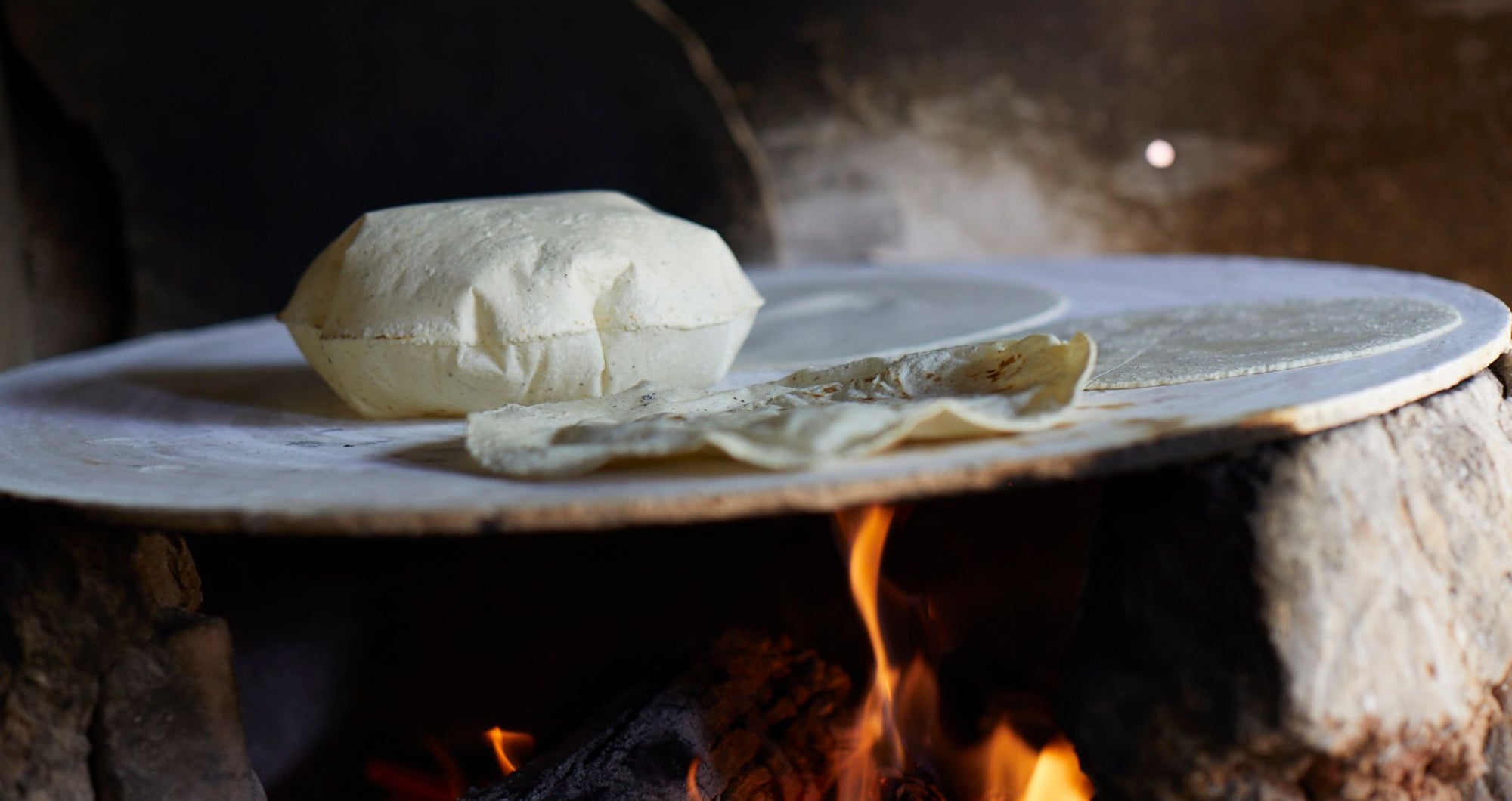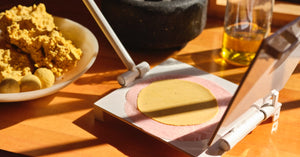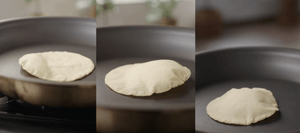The Anatomy of a Tortilla Puff
The Anatomy of a Tortilla Puff

May 3, 2022
Ah, the mythical puff. The puff can be thought of as equal parts culinary magic and Masienda metaphor.
In the literal sense, the puff is to table tortilla making what the crumb (immortalized by the “crumbshot”) is to bread baking. That’s to say, it’s a sign that your table tortilla (i.e., the pliable kind that you pass around the table and/or make into a taco) was superbly executed.
A puff occurs during the cooking process of a tortilla, wherein, once meeting heat, the trapped moisture at the tortilla’s core expands outward in the form of steam. A ballooning puff is born, as a result. Though a marvel to behold, it’s about far more than just aesthetics. The puff helps to ensure that the tortilla cooks evenly through the center while also maintaining proper moisture and elasticity.
With this in mind, the variables that will affect your puff are as follows. Note: If you are using masa harina, only items 1-3 will be of importance, because the grind and elasticity will have hopefully been worked out by the masa producer (you're definitely good to go with our Heirloom Corn Masa Harina!). I have included some puff troubleshooting tips afterward as well as a video we put together that brings some of these concepts to life.
- Moisture: My own rule of thumb is to take my masa to the upper limits of moisture, to the point just before I can’t physically manipulate it without it getting stuck to my fingers. At this point, if you were to make a masa ball and flatten it between your hands, there should be little to no cracking on the edges. When cooking the tortilla, I should easily be able to observe steam coming off the top of the tortilla. You need ample moisture that can react with the heat in order for it to ultimately convert to steam and puff. If your masa has too little moisture, the tortilla in development will dry out before it can ever puff. A proper mixing/kneading process is critical to ensuring well-distributed and even moisture.
- Compression: You don’t technically need a thinly-pressed tortilla for a puff. Look no further than a gordita, for example; this thick masa pancake will similarly puff like a table tortilla under the right conditions (its puff actually creates the pocket where you stuff it with delicious fillings, like you would with an arepa or a pita). But there is something to be said for the right amount of compression--achieved during the pressing--on a table tortilla; it can help ensure a sufficient compaction of the moist masa, where steam pressure can later build and expand outward in the form of a puff. The thicker a tortilla is pressed, the higher the temperature you'll need to cook through the center quickly. The thinner a tortilla is pressed, the faster the searing time should be--but keep the temp high, regardless.
- Temperature: No heat, no puff. Remember, we are searing both sides of a table tortilla fast enough to trap moisture in the center, which will expand in the form of steam, as heat eventually reaches the tortilla’s core. You want at least 400 F (med-high/high heat on your stovetop) to achieve this effect, though higher temperatures certainly won’t hurt, when managed effectively. The wood-fired clay comales you’ll find throughout Oaxaca, for example, average about 650 F; tortilla conveyor ovens in tortillerias will cook at an average of about 500 F between their various decks. This is all to say, table tortillas like it hot. If you sear too long on either side, you may be risking that your tortilla core dries out before you can create a proper puff.
- Grind: A fine grind allows for even distribution and retention of moisture. Think of a whole corn kernel for a moment: if you were to add water to the kernel, it wouldn’t absorb or retain very much moisture, if at all. This is obviously the most extreme example of a coarse grind, but it helps to illustrate why even a masa grind with sea-salt-sized kernel particles doesn’t retain as much moisture as a smooth, fine grind (think Play-Doh) would. The finer the grind, the higher the moisture uptake, the more likely the puff.
- Elasticity: The corn’s outer skin, or pericarp, is where we find the kernel’s natural gums. And while these gums can be a crucial element for binding the masa and ensuring that it does not fall apart, they are also important for producing a puff. When seared, a tortilla with some presence of pericarp creates an elastic skin/crust that more effectively traps and insulates moisture within its core. The more effectively moisture can be trapped within the center of the tortilla, the higher the steam pressure and the more robust your resulting puff.
Puff Troubleshooting:
- Following the second flip (i.e., when both sides have been seared and the tortilla’s first seared side is resting face down on the cooking surface), apply a bit of additional pressure to the surface of the tortilla with a flat spatula in order to coax along the puffing process. You may also do this with your fingers wrapped in a kitchen towel. The added compression can create just enough additional pressure to achieve liftoff.
- If you are working with pre-made masa harina, moisture is also the most common culprit behind a lack of puff. Masa harina is quite fine insofar as its grind is concerned, so this won’t be something to worry about. Just mix in a bit more water and do a quick smush test, repeating as necessary until it passes muster.
- If you are working with fresh masa from nixtamal you have prepared, I find that moisture is most often the culprit for a puffless tortilla, either before or during its cook. If your masa is too dry, it could be the result of 1) undercooked corn, 2) too coarse of a grind or 3) not enough water added during the mixing process.
- If you’re searing either side for too long, you might be drying out the moisture in the center of the tortilla before that moisture has the chance to be trapped inside and work its magic. This is especially more likely with a higher heat and/or a thinner-pressed tortilla. Think of searing a thin burger patty or a fish to medium/medium-rare temp--they can be easy to overcook, if you’re not timing each side according to the surface temperature you’re working with. Heat is, of course, necessary, just watch it closely.
- When handling the masa, it helps to wet your hands. You’ll almost never see a tortillera in Mexico without a bucket of water nearby for rinsing and moistening her hands. This helps to ensure that the masa doesn’t stick to your hands over time; it also helps insulate from the warmth and relative dryness of your masa-crusted hands, which will, believe it or not, gradually dry out the masa that you’re handling.
- I keep a spray bottle nearby to occasionally mist my tortillas with water while cooking, in order to ensure that they are never thirsty.
- If you're noticing that one side of your tortilla is inflating and the other is not, it's coming down to how you are pressing the masa before it’s cooked. It likely means that the tortilla is slightly thinner and more compressed on one side, causing a slightly uneven cook. When pressing your tortillas, be careful to not rest your hand on one side of the press when holding the press for stability. I used to unconsciously do this in the beginning, and it would always lead to an uneven distribution of pressure and partial puff.
- Watch for little holes in the tortilla where the steam can escape. These will limit your puff potential. Holes and cracks are more likely to occur when your masa lacks sufficient moisture and/or when the masa has not been mixed thoroughly or evenly enough.
Have any puff questions? Email us at info@masienda.com and we'll get back to you asap!
May the puff be with you,
Jorge



All Comments
Hi Samantha! Great question 😊 While tortillas made from Heirloom Corn Masa Harina are best enjoyed fresh for tacos, leftover tortillas are great for other applications such as enchiladas, quesadillas, tostadas, and totopos (chips). To store tortillas, make sure they have cooled completely. Then place them in an airtight container, or tightly wrapped in plastic, in your refrigerator for up to a week. Storing warm tortillas before they’ve cooled, may cause condensation which can lead to mold.
If your tortillas are breaking, they probably need more moisture. Try adding a little more water to your masa, one tablespoon at a time, until the dough feels like Play-Doh. Keeping them warm and covered after cooking helps too! Let us know if you have any additional questions.
How do you store them if you don’t eat them all? And how do you get them not to break when you make a taco with them?
Mine always seem to break 😩